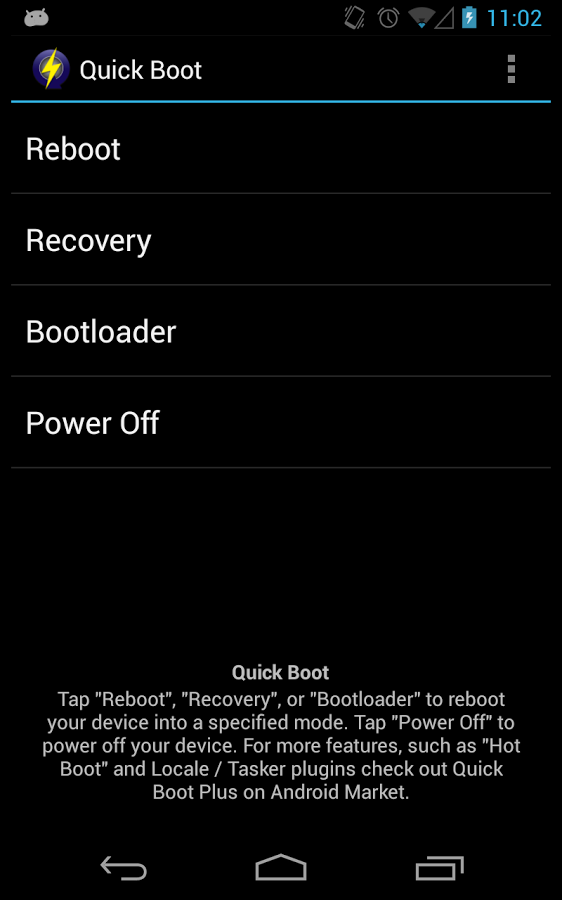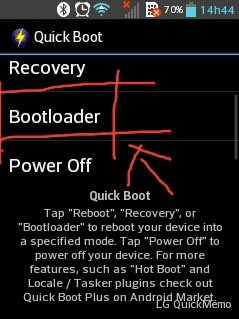

which, well, obviously doesn't work anymore. Also, busybox is still missing.)Īnd here's the final problem: the phone does not have a way to get into fastboot mode using hardware buttons, so I found myself having to type 'adb reboot bootloader' to get it into fastboot mode. (I suppose the permissions are messed up somewhere, chmodding went fine, but chowning did not. Applications are not getting root, either. Now, using an adb shell, I could simply get root by typing 'adb shell' followed by a simple 'su', and ta dah: root shell! Yet, somehow, the permissions on the su binary are all messed up - since when I use a terminal emulator on the device itself: I get presented with a 'Permission denied' error.
#ADB QUICKBOOT OFFLINE#
It shows the device - with an id of 0123456789ABCDEF as offline in the devices listing of adb. Now this is where the problem comes in: the hacked adbd no longer allows me to connect using adb. ( Please note: Before replacing adbd I had also installed the su binary in /system/bin and the Superuser.apk package) Replace adbd in /sbin with a version provided by a package called adbd insecure, which was supposed to automatically grant root access to adb-connections. Modify init.rc to mount /system as a rw filesystem, since (re)mounting /system is somehow not allowed by the kernel, even when root. Modify default.prop, setting ro.secure to 0, ro.debuggable to 1, and ro.adb.secure to 0.
#ADB QUICKBOOT ANDROID#
No known exploit-based root methods exist for this device (which runs on Android 4.4.2), so I found myself having to dissect boot.img using the MTK-Tools Perl-scripts.Īfter unpacking the boot image, I made some modifications in the initramfs, they are as follows: You can flash a device when it's in the fastboot bootloader mode.I own a relatively unknown Chinaphone, the CUBOT GT72+ (MTK6572 SoC) - on which I was attempting to gain root access.

Not all Android devices have fastboot enabled.Īndroid device manufacturers are allowed to choose if they want to implement fastboot or some other protocol. Fastboot does not require USB debugging to be enabled on the device. Fastboot allows to boot from a custom recovery image. If the mode is enabled, it will accept a specific set of commands sent to it via USB using a command line. It requires that the device be started in Fastboot mode. It is included with the Android SDK package used primarily to modify the flash filesystem via a USB connection from a host computer. It is implemented in a command-line interface tool of the same name and as a mode of the bootloader of Android devices. Communication with a device is done with a Transport.įastboot is a communication protocol used primarily with Android devices. On the other side, the Server continuously monitors for connecting Daemons (as USB devices or TCP emulator). On one side the Server exposes a “Smart Socket” to Clients such as adb or DDMLIB. The central part is the Server which runs on the Host computer. Three components of adb pipeline: As outlined in the overview, this codebase generates three components (Client, Server (a.k.a Host), and Daemon (a.k.a adbd)). this makes distribution and starting the server easier.ģ. Currently, a single 'adb' binary is used for both the server and client. Then, the client sends its service requests to the ADB server. It first tries to locate the ADB server on the host machine, and will start one automatically if none is found. ADB command-line client: The 'adb' command-line program is used to run adb commands from a shell or a script. The BOOTLOADER and RECOVERY states correspond to alternate states of devices when they are in the bootloader or recovery mode.ģ. Otherwise, the device is OFFLINE, meaning that the ADB server detected a new device/emulator, but could not connect to the adbd daemon. The ADB server considers that a device is ONLINE when it has successfully connected to the adbd program within it.

Its purpose is to connect to the ADB server (through USB for devices, through TCP for emulators) and provide a few services for clients that run on the host. ADB daemon (adbd): The 'adbd' program runs as a background process within an Android device or emulated system. The ADB server is really one giant multiplexing loop whose purpose is to orchestrate the exchange of data (packets, really) between clients, services and devices.Ģ. It thus maintains a list of "connected devices" and assigns a 'state' to each one of them: OFFLINE, BOOTLOADER, RECOVERY or ONLINE.

Its purpose is to sense the USB ports to know when devices are attached/removed, as well as when emulator instances start/stop. ADB server : This is a background process that runs on the host machine. 7.4 Extract a backup (.ab extension) on PCĪs a whole, everything works through the following components:ġ.3.2 Pair with a device for secure TCP/IP communication.


 0 kommentar(er)
0 kommentar(er)
